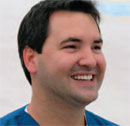Demystifying Dental Digital Photography
Tony Soileau, DDS
The increased use of digitalphotography in dental offices has led to many misconceptions about digital cameras and their use in clinical and marketing photography. Digital cameras can be very simple and cost effective to use. But digital technology often is not used simply or cost efffectively because the dentist is not taking advantage of the features available in today’s digital cameras, or they received advice from non-dental camera dealers who had great intentions but lacked dental photography experience. Because every dental practice is different, the photography and technology needs of each practice will vary. Problems surface when the photographical needs of the dental practicedo not coincide with the camera and associated technology being used by the dental team. This article will discussdifferent camera options to considerwhen purchasing a digital camera, and hopefully it will clear up some common misconceptions about digital cameras and their applications.
When purchasing a digital camera, one common misconception is that the smaller—and usually less expensive—point-and-shoot style cameras are easier to use than the larger and more expensive SLR digital cameras. The cameras seem less complicated because they have fewer features than SLR camera bodies. The total size of an SLR digital camera body, macro lens, and ring flash also can be intimidating, especially to team members who do not have much photography experience. But regardless of the larger size, SLR digital cameras are much easier to use and actually require fewer settings and adjustments to take consistently perfect images (Figure 1). However, there are some advantages to point-and-shoot cameras.
One advantage of point-and-shoot cameras is auto-focusing. Many team members like this feature because of its ease of use and precision results. To auto-focus, simply look at the monitor on the back of the camera and push the shutter button halfway down. The camera will then focus on the subject by itself. The camera can then be zoomed in and out to compose the image. This auto-focus feature can take full face and smile photos quite easily but will struggle to focus itself inside the mouth. This is because most point-and-shoot digital cameras focus by comparing the contrast found in the image. For the camera to evaluate the contrast it needs adequate light reflecting off the subject. The ambient lighting found in dental operatories, coupled with the small onboard flash found on most point-and-shoot digital cameras, is simply not enough. While the camera will focus efficiently enough for extraoral images, most offices find that their point-and-shoot digital cameras take too long to focus for intraoral images. Some point-and-shoot cameras can be equipped with an external ring flash or flash diffuser to direct the onboard flash into the mouth for intraoral images. While this will increase the cost and weight of the camera system, it will decrease the time it takes for the camera to focus inside the mouth.
Depth-of-field is another disadvantage of point-and-shoot digital cameras. Depth-of-field refers to how much of the image is in focus and how much of it is blurry. The number that corresponds to the amount of depth-of-filed is called the f-stop. The higher the f-stop number a camera lens can achieve, the more of the image will be in focus. Point-and-shoot cameras come with fixed lenses that can usually only go to an f-stop of 8 or 11. Digital SLR cameras use lenses that can achieve f-stops up to 32. What this means to dental photography is that a point-and-shoot style camera will not be able to take a photograph of a smile so that all of the teeth are in focus. It simply does not have enough depth of field. The centrals to the premolars will be in focus but the molars will be blurry. With an SLR camera, it will not only focus faster (or it can be focused manually) but everything will be in focus (Figures 2, 3 , 4).
Another misconception is that the more buttons a camera has the more complicated it must be to use, and therefore an SLR camera requires more photographic skill to use than a point-and-shoot camera. The opposite is true here as well. While SLR cameras do have more buttons and functions, they do not need to be used every time a photo is taken. In fact, these additional functions allow the camera to be automated so that fewer buttons are pushed compared to a point-and-shoot camera. An example of these automated functions is found on the Canon 20D digital SLR camera (Canon USA, Inc, Lake Success, NY). It has an internalsetting that allows the camera’s shutterto be “fixed” at 1/250 in AV mode. AV mode allows the photographer to set the f-stop and the camera sets the shutter speed. By fixing the shutter speed, along with the ISO and flash setting being constant, all the dentist/photographer has to worry about is the f-stop setting. For most point-and-shoot cameras thef-stop and shutter speed have to be changed for different views.
Depending on the model of macrolens used, an SLR camera can be setto autofocus the same way a point-and-shoot style camera functions (Figures 5 and 6). The Canon 100-mm macro lens has the ability to autofocus and be manually focused at the same time. This is especially helpful if the patient ordentist/photographer moves slightly after the shot is focused. The camera will notice this and correct the focus for you. This can be very helpful at the end of the day when your body is tired and your eyes don’t focus as well.
But do still keep in mind that point-and-shoot digital cameras do their job, within their limited capabilities, very well. They are lighter and less expensive than digital SLR cameras. Because all dental offices are small businesses, the cost of equipment must always be afactor to be considered. The key to making a wise purchase is to know what you are buying. If your primary concern isto buy an inexpensive camera, then a point-and-shoot camera will better fit your budget. You just have to accept its limitations—the difficulty and sometimes inability to focus inside the mouth, lack of depth of field so parts of the some image views will always be blurry, and more buttons and settings will have to be adjusted than with a digital SLR camera. However, for many offices, these are compromises that can be accepted. But as long as you know them before you purchase, you will not have any regrets.
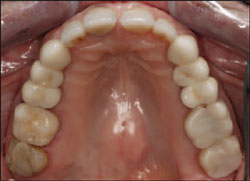 | 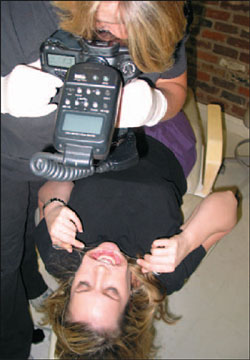 | ||||
| Figure 1 Maxillary intraoral photograph taken with a Canon 20D digital SLR camera. | Figure 2 Using a digital SLR to photograph retracted smile. | ||||
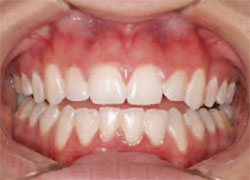 | 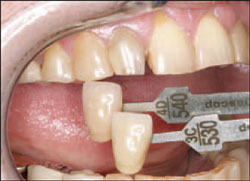 | ||||
| Figure 3 Retracted smile taken with digital SLR camera. Notice all teeth are in focus. | Figure 4 Lab communication photograph taken with digital SLR. Notice the detail captured with the Canon 20D. | ||||
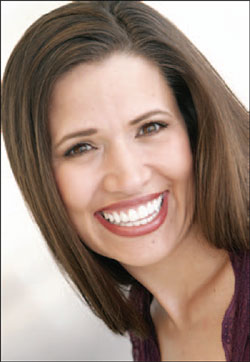 | 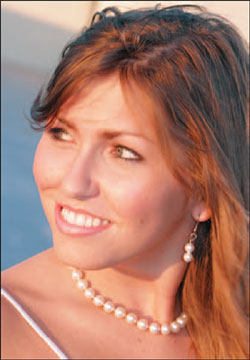 | ||||
| Figure 5 Portrait-style photograph taken with the auto-focus setting using the Canon 20D. | Figure 6 Another example of portrait-style photograph using the same setting on the Canon 20D. | ||||
| |||||


